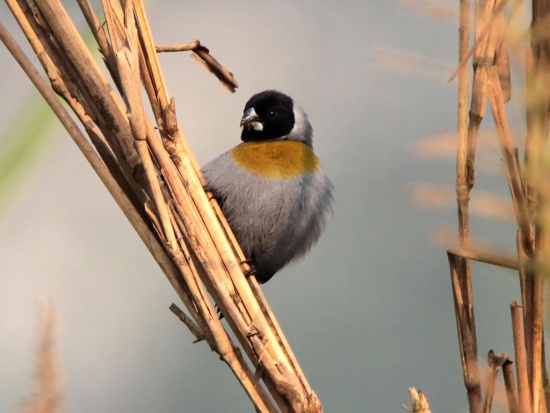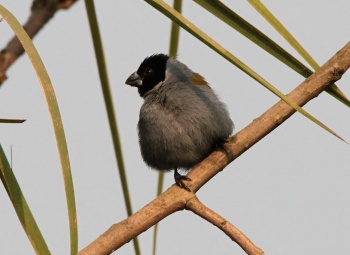(pictures added and some info) |
(→External Links: Removed African Bird Image database.) |
||
| (2 intermediate revisions by 2 users not shown) | |||
| Line 1: | Line 1: | ||
| − | |||
[[Image:456 wco sm filtered.jpg|thumb|550px|right|Male<br />Photo by {{user|martinuk|martinuk}}<br />Fort Portal, Kabarole District, [[Uganda]], July 2013]] | [[Image:456 wco sm filtered.jpg|thumb|550px|right|Male<br />Photo by {{user|martinuk|martinuk}}<br />Fort Portal, Kabarole District, [[Uganda]], July 2013]] | ||
| − | + | '''Alternative name: Olive Weaver-finch''' | |
;[[: Category:Nesocharis|Nesocharis]] ansorgei | ;[[: Category:Nesocharis|Nesocharis]] ansorgei | ||
| − | |||
==Identification== | ==Identification== | ||
| + | 10cm. | ||
| + | ====Male==== | ||
| + | [[Image:535 wco sm filtered.jpg|thumb|350px|right|Female<br />Photo by {{user|martinuk|martinuk}}<br />Fort Portal, Kabarole District, [[Uganda]], July 2013]] | ||
| + | * Black head and throat | ||
| + | * Grey nape | ||
| + | * Olive upperparts, blackish-brown upperwing | ||
| + | * Blackish tail | ||
| + | * White collar between breast and throat | ||
| + | * Olive breast, more yellowish in centre | ||
| + | * Grey rest of underparts | ||
| + | ====Female==== | ||
| + | * Reduced or lacking white collar | ||
| + | * All grey underparts | ||
| + | Juveniles are undescribed. | ||
==Distribution== | ==Distribution== | ||
Found in the Albertine Rift region of [[Uganda]], [[Rwanda]], eastern [[DR Congo]] and extreme northwest [[Tanzania]].<br /> | Found in the Albertine Rift region of [[Uganda]], [[Rwanda]], eastern [[DR Congo]] and extreme northwest [[Tanzania]].<br /> | ||
Uncommon to scarce but probably overlooked. | Uncommon to scarce but probably overlooked. | ||
==Taxonomy== | ==Taxonomy== | ||
| − | This is a [[Dictionary_M- | + | This is a [[Dictionary_M-O#M|monotypic]] species.<br /> |
May form a superspecies with [[Shelley's Oliveback]] and is even sometimes considered conspecific. | May form a superspecies with [[Shelley's Oliveback]] and is even sometimes considered conspecific. | ||
| + | |||
==Habitat== | ==Habitat== | ||
Found in papyrus swamps, lakeshore thickets, in bushes and trees bordering streams and in marshy forest edges.<br /> | Found in papyrus swamps, lakeshore thickets, in bushes and trees bordering streams and in marshy forest edges.<br /> | ||
Occurs from 1000 to 1900m. | Occurs from 1000 to 1900m. | ||
==Behaviour== | ==Behaviour== | ||
| + | ====Diet==== | ||
| + | Feeds on small seeds. | ||
| + | Forages actively at all levels, in pairs or in small groups. Gleans at branches and leaves, often hangs upside-down. | ||
| + | ====Breeding==== | ||
| + | Breeds in wet season. Uses old nests of other species for breeding, particularly nests of [[Strange Weaver]] and [[Spectacled Weaver]]. Lays 2 to 3 eggs. | ||
| + | ====Movements==== | ||
| + | A resident species. | ||
| + | ==References== | ||
| + | #{{Ref-Clements6thOct12}}#{{Ref-HBWVol15}} | ||
| + | {{Ref}} | ||
==External Links== | ==External Links== | ||
{{GSearch|Nesocharis+ansorgei}} | {{GSearch|Nesocharis+ansorgei}} | ||
| − | |||
| − | |||
[[Category:Birds]][[Category:Nesocharis]] | [[Category:Birds]][[Category:Nesocharis]] | ||
Latest revision as of 00:05, 28 April 2020
Alternative name: Olive Weaver-finch
- Nesocharis ansorgei
Identification
10cm.
Male
- Black head and throat
- Grey nape
- Olive upperparts, blackish-brown upperwing
- Blackish tail
- White collar between breast and throat
- Olive breast, more yellowish in centre
- Grey rest of underparts
Female
- Reduced or lacking white collar
- All grey underparts
Juveniles are undescribed.
Distribution
Found in the Albertine Rift region of Uganda, Rwanda, eastern DR Congo and extreme northwest Tanzania.
Uncommon to scarce but probably overlooked.
Taxonomy
This is a monotypic species.
May form a superspecies with Shelley's Oliveback and is even sometimes considered conspecific.
Habitat
Found in papyrus swamps, lakeshore thickets, in bushes and trees bordering streams and in marshy forest edges.
Occurs from 1000 to 1900m.
Behaviour
Diet
Feeds on small seeds. Forages actively at all levels, in pairs or in small groups. Gleans at branches and leaves, often hangs upside-down.
Breeding
Breeds in wet season. Uses old nests of other species for breeding, particularly nests of Strange Weaver and Spectacled Weaver. Lays 2 to 3 eggs.
Movements
A resident species.
References
- Clements, J. F., T. S. Schulenberg, M. J. Iliff, B.L. Sullivan, C. L. Wood, and D. Roberson. 2012. The eBird/Clements Checklist of Birds of the World. 6th ed., with updates to October 2012. Ithaca: Cornell Univ. Press. ISBN 978-0801445019. Spreadsheet available at http://www.birds.cornell.edu/clementschecklist/downloadable-clements-checklist
- Del Hoyo, J, A Elliott, and D Christie, eds. 2010. Handbook of the Birds of the World. Volume 15: Weavers to New World Warblers. Barcelona: Lynx Edicions. ISBN 978-8496553682
Recommended Citation
- BirdForum Opus contributors. (2024) White-collared Oliveback. In: BirdForum, the forum for wild birds and birding. Retrieved 14 May 2024 from https://www.birdforum.net/opus/White-collared_Oliveback





